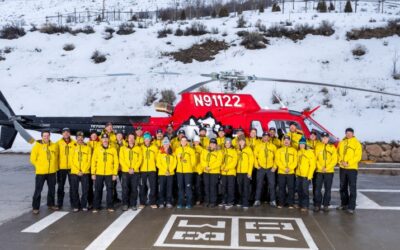The sun is beginning to rise over the Mission Mountain Range, and Jason Mahlen has lost count of how many lake trout he’s caught from his boat in the middle of Flathead Lake, Montana.
Flathead Lake is one of the cleanest lakes in the world. It’s filled with crystal clear water that flows out of protected lands of the Forest Service and Glacier National Park. The lake stretches for nearly 200 square miles. The southern half lies within the boundary of a sovereign nation: The Confederated Salish and Kootenai Tribes of the Flathead Reservation.
Colonizers introduced the invasive lake trout to Flathead Lake more than 100 ago to increase fish production for recreation. And as these fish keep populating, they are pushing native fish species like bull trout to extinction.
Mahlen expects to catch about two coolers worth of lake trout today—roughly 100 fish. In a rhythm with two fishing poles, Mahlen has only caught lake trout this morning.
He’s noticed changes to these fish over the last 20 years—like how big they’ve gotten from eating a lot in the lake.
“I could’ve put 100 fish in that cooler, no problem,” Mahlen says. “And now you can put 50 in there. You got trouble closing the lid.”

After catching a lake trout in Flathead Lake, Jason Mahlen is putting it in a cooler getting full of trout. (Courtesy Of Ellis Berry)
The Rocky Mountains are experiencing an average increased temperature of 2 degrees Fahrenheit due to carbon emissions being emitted into Earth’s atmosphere. Warmer water temperatures make it easier for non-native trout like lake trout to thrive while native fish struggle.
And now, lake trout have begun to invade the rivers and streams around Flathead Lake.
“A lot of invasive species are invasive because they’re better at dealing with the changing planet that we are creating,” said Charles van Reese. “It’s tipping the scales towards the invasive fish.”
Van Reese, a postdoctoral research associate at the University of Montana’s Flathead Lake Biological Station, was actively trying to save another native trout species headed to extinction: the westslope cutthroat trout.
Native trout species like westslope cutthroat and bull trout have become genetically diluted as the species interbreeds with non-native fish. Genes are being mixed, and with repeated cross-breeding, a species may be lost forever.
Van Reese and his team were looking for the specific genetic makeup of non-native trout that allows them to withstand human-induced climate change. That information will allow scientists to detect and potentially prevent invasive species from genetically diluting a population and increase the odds of native trout passing on genes that make them more resilient to warming waters.
Van Reese said if species extinction is preventable, humans should try to do that.
“But in my opinion, when you think about any species on the planet, this is a biological lineage that has persisted for billions, millions of years to become what it is,” said van Reese. “It’s beautiful, it’s unique, it’s never gonna happen again. Where do we get this idea that it’s okay to destroy that?”
Barry Hanson is the Confederated Salish and Kootenai Tribes Fisheries Biologist. He has been working with Montana fish for over 30 years.
“Tribes are in a unique position because they have a long history with species that occurred here, evolved here,” said Hanson. “Whereas most nontribal people are fairly newly arrived here. And so don’t have the history or the attachment to the native species like tribal people do.”
Hansen and his team have been actively working on suppressing lake trout by 75%. They want to keep some lake trout around for fishing guides who are financially invested in that species of fish.
Hansen said that native trout have been adapting to changes to the lake for centuries but are now decreasing in population. He said the least humans can do is try to take out the introduced and invasive trout species to help native trout survive.
One way they do that is by hosting Mack Days on Flathead Lake where anglers are invited to come catch and kill as many lake trout as they want for cash prizes.
“And then even if you had the lake trout problem removing the lake trout wouldn’t be enough because that doesn’t fix your climate change issue,” said Hansen. “So, we can fix the lake trout issue and we have the resilience to climate change in this system.”
The two-degree change in temperatures means ecosystems are changing, threatening species extinction at Flathead Lake. Agencies that monitor fish around the lake are actively researching how they can help native species survive, keeping Flathead Lake what it has been for centuries.
From his boat out on the water, Jason Mahlen, for one, talks about how much he loves Flathead Lake.
“It’s so beautiful out here, ya know,” he said.





